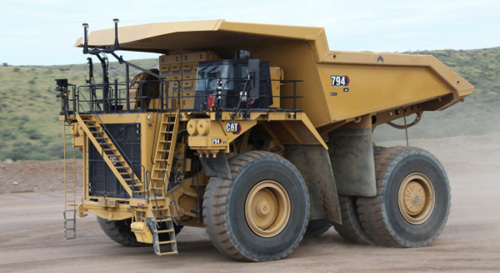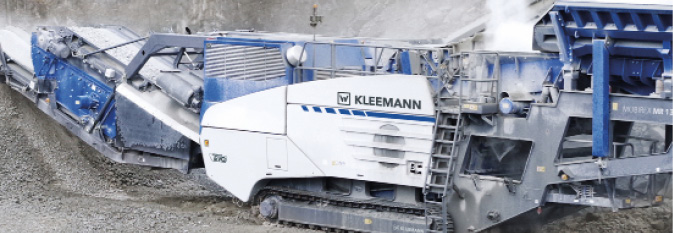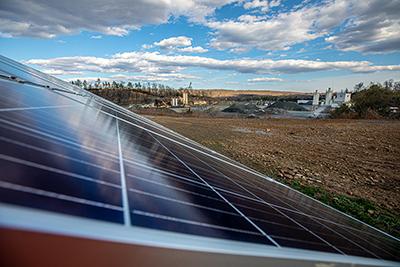Innovative Designs And Strategies Will Benefit Quarry Operations Around The World.
By Toni Allen
Without technology, there’s no mining. Ever since the most primitive forms of rock extraction with sticks and picks, innovative tools have continuously reshaped the way we gather and produce minerals and metals.
As with any industry that focuses on natural resource extraction, increased awareness of the environment inevitably results in new innovative designs with efficiency at the forefront.
Here are some recent innovative designs and strategies reshaping quarry operations around the world.
Electric Mining Equipment
Perhaps the biggest technological shift in the mining industry has come from the transition away from fossil fuel energy sources.

Electric mining equipment is quieter, cleaner and generates far less heat than diesel-powered alternatives, for example. As electricity from solar, wind, geothermal and hydroelectric sources becomes cheaper, these machines will result in greater efficiency.
All the while, diesel prices continue to rise. It’s worth noting that the price of crude oil is the biggest factor in the price of diesel. And geopolitics can cause significant volatility in oil markets.
A downside to the electrical shift in mining machinery could be maintenance. Older, purely mechanical machines might encounter more frequent problems, but they are typically easy to fix. To build and maintain the new generation of machines, engineers must be trained to focus on finer aspects of technology – this comes with a higher price tag from machine producers.
Another questionable aspect is the current state of battery technology. An electric crushing and screening machine working its way through several hundred tons of gold ore will need more than a lithium-ion Lego-like ensemble attached to the belly. In the meantime, hybrid rigs are a suitable interim solution.
Lowered-Emission Diesel Engines
Mass-produced mining machinery companies can now produce diesel-powered rigs that meet European Stage V standards, as well as the EPA’s Tier 4. Until electric motors reach a sufficient design that can handle quarry workload, lower-emission diesel, and hybrid diesel engines have a future.
Hybrid diesel engines provide a way to transition to fully electric. It’s also easier for manufacturers to curb performance and meet emission standards on a motor with electric assistance.
3D Printing and Mapping
Still on the cutting edge, 3D printing can be a revolutionary resource-saver for many quarries.
One of the biggest expenses in mining operations is the replacement of key equipment parts – the costs are vast, including those of the component, transport, fitting, and ongoing maintenance. As 3D printing machines become more sophisticated, so do the items they’re able to produce without hand-to-material assistance.
Once upcoming 3D modeling machines meet the required standards, more quarries may invest in on-site machines to eliminate costs of equipment parts and their transportation.
Integrating 3D printing technology into a quarry means spare parts can be stored in a digital library. Provided the right materials are in store, these parts can be printed on demand without heavily depending on suppliers.
New costs to consider are the machine’s price, setup, operation, and any training required to do that. Digital part samples may also be charged a license fee by part manufacturers.
Mining Simulations and Digital Twinning
Since we’re into saving time and money, we can’t leave out mining simulations. Virtual reality (VR) software can be utilized to get a better grasp of hypothetical scenarios. This brings with it the potential to eliminate more mistakes before implementing live changes.
As for digital twinning, replicating an object digitally can ease the process of quarry design. This ties in directly with automated quarry management, since the workplace layout is a key component of a smooth operation. Twinning models could mean seamless digital designs with to-the-millimeter accuracy.
Mobilized Crushing and Screening Equipment

Heavy drop-hammer technology has evolved since the filing of the first U.S. patent for a crushing machine. Crushing machines met fragility when they also became complexified screening machines. As a key component of processing mined ores, innovation for this type of equipment was stationary for decades.
In recent years, several mobile crushing and screening manufacturers entered the market with lighter, simplified crushing machinery and relatively “dumb” technology for easier screening operations. When mobilized, such machinery creates opportunities for a growing rental sub-market. It’s also resource efficient – experts can travel with the machine if needed and the rig is more adaptable to unexpected requirements for movement.
Renewable Energy to Power Mining and Processing Plants
Mining operations continue to invest in building fields of solar panels to power their operations. With a carefully managed system, these facilities can gather enough concentrated solar power (CSP) or photovoltaic power (PV) to fuel most of their entire electricity-dependent operations.
Other renewable energy sources growing in popularity at mining plants include:
- Wind turbines.
- Geothermal systems.
- Biodiesel.
- Hydroelectric power.
With mounting pressure from environmental policy makers, companies look for other incentives to make the most of transitioning to alternative energy sources. The same enterprises are exploring other hybrid or fully electric toolsets and technologies.
Automated Quarry Management
Any change in operational management must be planned with health and safety measures at the forefront.
Automated quarry management covers a broad range of operational changes, like:
- Self-driving vehicles.
- Specialized processing lines ran by sophisticated software.
- Digitized environmental assessment.
Automated machinery is heavily dependent on adequate software. This means that quarry management is another subsidiary sector expecting to see a shift from person-to-person workflow to “code” managers.
The application of digital advancement is further shown through the likes of mobile laser scanners. The creation of digital surface models allows far easier data collection in comparison to the use of terrestrial scanners. It’s faster and cheaper.
Faster and cheaper surface models lead to more frequent and up-to-date data on gradients, depths and slopes. This allows more money to go toward the machinery needed to deal with those challenges and increase productivity throughout the quarry.
X-Ray Diffraction in Mineral Processing

To note something interesting on the metals mining side, X-ray diffraction (XRD) allows analysts to obtain quick measurement of a material’s crystallographic structure. Today, it’s an important technology used to determine the mineral composition of precious metals and other mined ores.
XRD machinery sends radiation through the examined material. Then it measures the angles and intensity at which the rays are scattered throughout. The calibrated equipment allows processing technicians to identify an ore’s mineral content in a fraction of the time compared to traditional methods.
For example, an XRD scan of gold ores would likely indicate minerals such as quartz, various clays, muscovite and calcite present. It would also indicate the composition phase for each mineral.
Alongside XRD, X-ray fluorescence (XRF) is another type of technology used. While XRD indicates the types and amount of minerals present, along with the composition phase, XRF produces information about the detailed chemical make-up of those.
As such XRF has applications in environmental and processing monitoring as well as in exploration and other operations. In addition XRF is used in the retail sector in the pricing of gold and other precious metals.
Toni Allen is an editor at Commodity.com, a leading resource on commodities markets and trading.
